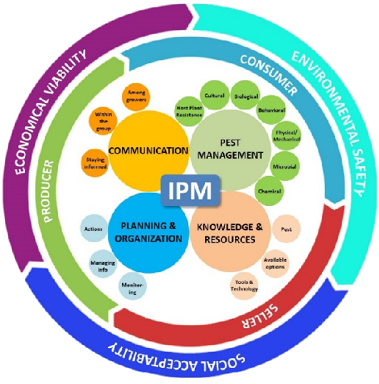Changing the way we grow food was (and remains) the vision of Madumbi founder and CEO, Andre Fox. Andre is a visionary leader in the agricultural industry, recognised for successfully pioneering and navigating the biological conversation in an environment resistant to change.
Today, there is no doubt that change is upon us. Environmental issues are at the forefront of every conversation and the current COVID-19 pandemic is set to challenge every norm. Now, more than ever, healthy, sustainable food production is in the spotlight.
Biorational solutions are expected to play a critical role in meeting this demand. The biocontrol market is growing globally at between 15–17% CAGR. The organic market and the biocontrol market are often incorrectly perceived to be the same, however it’s important to note that the organic market is not driving the rapid growth of biocontrol. The organic market is growing at 11% CAGR and represents 10% of the biocontrol market use1.
There are many factors contributing to the rapid growth within biocontrol with some of the main ones being:
- Consumer demand
- The unsustainable cost of developing traditional pesticides
- Development of pest resistance and the need for biological products as resistance management partners.
“There’s a much higher level of acceptance now than there was ten to fifteen years ago. Today’s consumer is demanding residue-free, nutrient-dense food to feed their families and be safe doing so,” says Andre Fox, Madumbi CEO.
The use of biocontrol products is not expected to displace traditional crop protection products in the foreseeable future1.
However, the growth is anticipated by the increased usage of biocontrol products within Integrated Pest Management (IPM) systems – a combined program of biocontrol and traditional products, for the best cost-benefit, yield production and sustainability
New European regulations on chemical usage and MRL’s challenge export growers
Maximum residue limits (MRL’s) are the limits on the maximum amount of a particular pesticide which is permitted in food.
The lowering of MRL’s in certain markets, places increasing pressure on growers. While it is largely several European countries and supermarkets driving these changes, some do filter down to local South African markets and producers. The most demanding markets, from an MRL perspective, are often the more lucrative markets, providing significant incentive for growers to try and produce within the set limits.
Biocontrol products have a critical role to play in assisting growers to meet these MRL limits without compromising on pest control and crop quality
Biological solutions in IPM programs
Integrated Pest Management (IPM) is a term widely accepted and implemented in agricultural crop production across the globe. Definitions of IPM vary depending on the source, but generally relate to “ecosystem” approaches, where a combination of methods is used to grow healthy crops with reduced pesticide usage.
A new IPM model, by Dr Surendra K Dara, redefines IPM as an approach to “managing pests in an economically viable, socially acceptable and environmentally safe manner”. This comprehensive model incorporates all parties, including the producer, seller and consumer.
The key take out of the new IPM model is “Crop production is an art, science and business” (Dara). Each grower needs to develop their own program to produce crops, minimise loss and remain profitable in a way that is socially acceptable, safe for the consumer and environmentally sound.
New IPM Model, Dr. S. Dara
The model is centered on four pillars, unique to each grower:
- pest management: a combination of cultural, physical, biological and chemical options
- knowledge and resources – which impact directly on the growers decision making ability
- planning and organisation – successful implementation “on the ground”
- communication – which ensures the transfer of collective knowledge to share internally and externally.
As a new IPM paradigm evolves to ensure food security for the growing world population, so too does the role of biological solutions. The modern consumer drives the demand for healthy, food production. Growers are under increased pressure to produce ecologically sound, nutrient-dense food while protecting the environmental integrity for future generations. Growers implementing an IPM approach need to make a similar mindset change with biological and biorational solutions. The increased incorporation of biological solutions, including biological pest and disease control products, microbial soil inoculants and biostimulants contributes significantly to healthy crop production with reduced environmental impact.
Traditionally, IPM programs are developed around the maximum use of chemical solutions, while ensuring MRL levels are met. At Madumbi, we believe a paradigm shift is needed. Biological and non-chemical solutions should be incorporated first and utilized to their full potential, with chemical solutions completing the program
“What I find particularly exciting is that with new innovation, research and product development, the basket of biological solutions is growing. As this ‘toolbox’ gets bigger and more diverse, the opportunity for biologicals to take centre stage in IPM programs increases, encouraging reduced dependence on chemical interventions,” says Dr Brendon Neumann, Madumbi Business Innovations lead.
Biological solutions unpacked
Biological control offers “natural” pest management solutions where “natural enemies” are used to control a pest species. “Natural enemies” may include parasitoids, predators, entomopathogenic nematodes, competing micro-organisms etc.
Each biological solution is unique with specific features and benefits.
A summary of some of these benefits includes:
- Unique and multiple modes of action, offer good efficacy with low risk of resistance build up
- Ideal for resistance management with conventional chemicals in IPM programs
- Low to no impact on beneficial insect populations
- No maximum Residue Limits (MRL’s)
- Good compatibility, user friendly products that can often be incorporated into tank mixes
- Chilled storage and improved logistics offer good shelf life
- Natural products – several of which are certified for use in organic production.
Biological solutions are deserving of more recognition in the growers “IPM tool kit”. Technology has developed rapidly over the past 20 years with proven results on selected crops, pests and diseases.
References
Dunham Trimmer report 2019
Dr Surendra Dara. https://ucanr.edu/blogs/blogcore/postdetail.cfm?postnum=28210
Baker, Green, Loker – Science Direct, Biological Control, 2019



